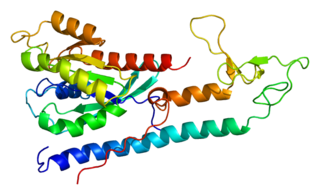
Rab escort protein 1 (REP1) also known as rab proteins geranylgeranyltransferase component A 1 is an enzyme that in humans is encoded by the CHM gene.

Ras-related protein Rab-6A is a protein that in humans is encoded by the RAB6A gene located in the eleventh chromosome. Its main function is the regulation of protein transport from the Golgi complex to the endoplasmic reticulum and the exocytosis along with the microtubules.

Ras-related protein Rab-3A is a protein that in humans is encoded by the RAB3A gene. It is involved in calcium-triggered exocytosis in neurons.

Syntaxin-binding protein 1 is a protein that in humans is encoded by the STXBP1 gene. This gene encodes a syntaxin-binding protein. The encoded protein appears to play a role in release of neurotransmitters via regulation of syntaxin, a transmembrane attachment protein receptor. Mutations in this gene have been associated with neurological disorders including epilepsy, intellectual disability, and movement disorders.

Nuclear factor of activated T-cells, cytoplasmic 3 is a protein that in humans is encoded by the NFATC3 gene.

Exocyst complex component 4 is a protein that in humans is encoded by the EXOC4 gene.

Exocyst complex component 2 is a protein that in humans is encoded by the EXOC2 gene.

Origin recognition complex subunit 6 is a protein that in humans is encoded by the ORC6 (ORC6L) gene.

Rab proteins geranylgeranyltransferase component A 2 is an enzyme that in humans is encoded by the CHML gene.

Exocyst complex component 7 is a protein that in humans is encoded by the EXOC7 gene. It was formerly known as Exo70.

Exocyst complex component 3 is a protein that in humans is encoded by the EXOC3 gene.

Exocyst complex component 5 is a protein that in humans is encoded by the EXOC5 gene.

Exocyst complex component 1 is a protein that in humans is encoded by the EXOC1 gene.

Actin-related protein 2/3 complex subunit 1A is a protein that in humans is encoded by the ARPC1A gene.

Exocyst complex component 8 is a protein that in humans is encoded by the EXOC8 gene.

Rab11 family-interacting protein 4 is a protein that in humans is encoded by the RAB11FIP4 gene.

Condensin complex subunit 3 also known as condensin subunit CAP-G (CAP-G) or non-SMC condensin I complex subunit G (NCAPG) is a protein that in humans is encoded by the NCAPG gene. CAP-G is a subunit of condensin I, a large protein complex involved in chromosome condensation.

Gamma-tubulin complex component 3 is a protein that in humans is encoded by the TUBGCP3 gene. It is part of the gamma tubulin complex, which required for microtubule nucleation at the centrosome.

Exocyst complex component 3-like is a protein that in humans is encoded by the EXOC3L gene.

Exocyst complex component 6B is a protein that in humans is encoded by the EXOC6B gene.


















